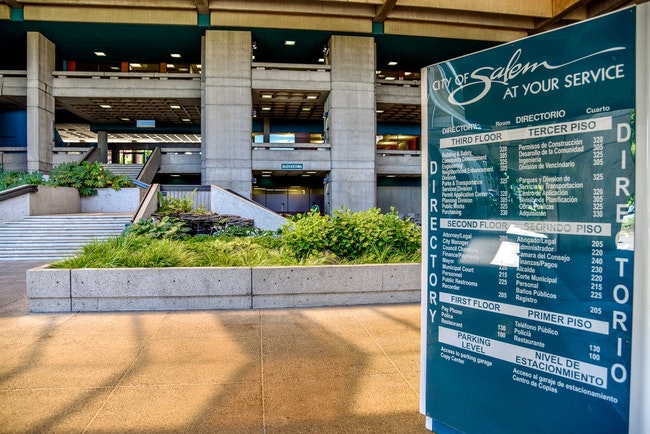
An idea to bridge the divide between protecting an area that the city has spent millions investing in and humanely treating the homeless in Salem may have come in the throes of an illness.
Councilor Cara Kaser got sick after the Salem City Council’s Feb. 10 meeting and was restlessly trying to get some sleep when she started thinking about what the city has been doing to tackle the persistent homeless problem downtown.
For months people have taken refuge under the awnings of downtown businesses, accumulating belongings and using the sidewalks as a bathroom.
“I couldn’t stop thinking about how are we going to make a way forward here,” said Kaser, a chief information officer at Oregon Business, the state’s economic development agency.
City councilors and officials have grappled with that for months, shifting from one solution to another in ways that seemed to please no one.
The main concern she heard echoed at city council meetings and through emails about a potential sit-ordinance, which would ban sitting or lying on sidewalks from 7 a.m. to 9 p.m., was: “Where are people going to go during the day?”
So, Kaser focused her energy on day spaces, realizing that people could sleep in public spaces at night.
“We can provide some day space and can couple that with an ordinance to address the behavior,” she said. “This might be that middle ground that I personally have been striving for.”
The first-term councilor was elected to represent Ward 1, which covers downtown and portions of west Salem, in 2016. Her term expires at the end of this year and she isn’t seeking re-election.
Kaser bounced her idea to councilor Chris Hoy, who thought it could work.
Hoy said he and Kaser tried to find an outcome that their colleagues could live with.
“We have been working together to forge a path through this kind of quagmire of ideas and suggestions,” Hoy said.
Then they took her plan to Urban Development Director Kristin Retherford and Jimmy Jones, the executive director of the Mid-Willamette Valley Community Action Agency.
On Monday, Feb. 24, the Salem City Council voted 7-1 for her amended ban. Councilor Jim Lewis was the sole dissenting vote and councilor Tom Andersen was absent.
Kaser read her motion aloud twice, so each councilor heard each section of the proposal. She didn’t provide copies of the motion. Councilors are expected to get more information about implementing the ban March 9.
Dan Clem, executive director of Union Gospel Mission, said there are currently around 50 men who utilize his organization’s day room, which is open from 6 a.m. to 11 p.m. He said it could fit another 25 men comfortably, but they have to be willing to come in.
“You can’t force them in. It begs the question, what impels them? Maybe after the ordinance passes, that would do it. It always remains to be seen,” Clem said.
The ARCHES Project has more limited hours, opening from 8:15 a.m. to 3 p.m. Monday through Friday.
Jones said even an expanded day center at ARCHES can’t meet the needs for Salem’s homeless population.
The center currently sees around 125 people a day. Jones said increasing the day center’s hours isn’t going to be cheap.
“The kinds of expansion being discussed here, including weekends and nights will certainly push toward $1 million a year on top of our current operating budget, annually. Even a minimal expansion from 3 to 6 p.m., Monday through Friday will likely cost an additional $400,000 a year,” Jones said in an email.
There’s also a provision that requires bathrooms at the day center, and for the city to establish permanent public restrooms downtown.
That move towards more restrooms was among the recommendations from the now-defunct city Downtown Homeless Solutions Task Force, which Kaser chaired in 2018.
When tents popped up around The ARCHES Project in December, the city brought in portable toilets and hand washing stations. Kaser said the company supplying the toilets subsequently refused to rent them to the city again after finding damage and hypodermic needles inside.
The city could use urban renewal funds to buy a bathroom, but can’t use that money for operational costs, like staffing someone to monitor it and maintain it.
“We have to have some kind of management component,” Kaser said. “Even if we owned Port o’ Potties we couldn’t get anyone to service them.”
City officials have floated the idea of installing a Portland Loo, a standalone bathroom that’s marketed as easy to clean and graffiti-proof.
Marion Square Park’s bathroom is currently closed because of extensive damage. The city is looking at what it would cost to re-open. City spokeswoman Kathy Ursprung said it would require replacing plumbing fixtures, dispensers and interior lighting, and a new coat of graffiti-resistant seal.
The Oregon Parks and Recreation Department selects designs and materials that are more resistant to damage when it builds restroom facilities, said spokesman Chris Havel.
He said many parks providers have started installing CXT units, which are more hardened and resist vandalism.
Kaser’s motion also keeps the ban from being linked to the city’s crime prevention districts, also known as exclusion zones, so violating the sit-lie restriction wouldn’t be a crime.
“I personally struggle with the idea of an individual or group of individuals using public space as their own private space. Just the idea of occupying public space with yourself and your things,” she said.
Correction: The Salem City Council voted 7-1 to move forward with an amended ban. Councilor Tom Andersen was absent.
Have a tip? Contact reporter Saphara Harrell at 503-549-6250, [email protected] or @daisysaphara.









